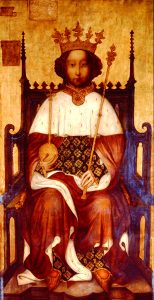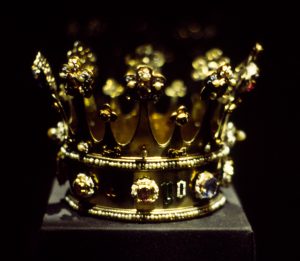The posts on this blog starting in February have featured various medieval topics that arise in my first Lady Apollonia novel, Effigy of the Cloven Hoof. In future months, I plan to do the same kind of posts for my other novels, starting with Plague of a Green Man in June. This posting will comment on some important medieval topics not addressed earlier.
Before speaking to them, I would like to mention my inspiration for the role which the crown of Anne of Bohemia plays in the conclusion of my story. Pictured above is The Crown of Margaret of York which I observed in 2002 in the Treasury of Aachen Cathedral in Germany. It dates to the 15th century but gave me a good idea of what kind of crown might have been worn by King Richard II’s wife, Anne of Bohemia.
The first general topic is the role which social class played in England at the end of the 14th century. Here, I should explain that until the 14th century, medieval Europe was based on just three classes: the aristocrats, the clergy, and the peasants. The first two groups owned or controlled the land and included almost all the literate population. The last of the groupings included 90% of the population who owned little, and almost all were illiterate.
A new group of the lower class emerged in 14th century England, the merchants. These people were not aristocrats, but the successful ones were able to achieve two things which had been characteristic of the nobility: the acquisition of wealth and property.
Lady Apollonia was born a noblewoman, being the daughter of the Earl of Marshfield. Her brother, Ferdinand, inherited the title and the property that came with it when their father died. Two members of the Lady’s household or personal affinity were clergymen: Brother William and Friar Francis. Many others in her affinity came from peasant stock or from merchant’s families. The Lady’s first husband was noble—Sir Geoffrey Montacute of Colerne Leat. Then, she married down into the merchant class for her subsequent marriages to Edward Aust and Robert Windemere. As a widow she inherited lands and fortunes from all three husbands.
 Another historic fact that arises in my first book is the usurpation by Henry Bolingbroke of the English throne of King Richard II. Though Bolingbroke was a member of the royal family, he was not in line to inherit the throne. His usurpation occurred in 1399 and contributed significantly to the uncertain times in England of 1400 when my book is set. The death of Richard II, whose official portrait is shown at the left, occurred while he was imprisoned. This encouraged people to question Henry IV’s motive to have him dead while still in his thirties and contributed significantly to those troublesome times. I also deal with this subject in my most recent book number seven, Usurper’s Curse, set in 1406 during the rule of the usurper, King Henry IV.
Another historic fact that arises in my first book is the usurpation by Henry Bolingbroke of the English throne of King Richard II. Though Bolingbroke was a member of the royal family, he was not in line to inherit the throne. His usurpation occurred in 1399 and contributed significantly to the uncertain times in England of 1400 when my book is set. The death of Richard II, whose official portrait is shown at the left, occurred while he was imprisoned. This encouraged people to question Henry IV’s motive to have him dead while still in his thirties and contributed significantly to those troublesome times. I also deal with this subject in my most recent book number seven, Usurper’s Curse, set in 1406 during the rule of the usurper, King Henry IV.
The last topic I want to discuss briefly in this post is leprosy. In the Middle Ages, leprosy was truly feared by everyone at that time but not understood very well. It is thought that many types of skin disease may have been called leprosy. People were afraid to have contact with lepers, and they were ostracized from society. Effigy of the Cloven Hoof begins with a great storm and a tidal bore on the River Severn which kills a number of unsheltered lepers traveling through Lady Apollonia’s lands on their way to a leper hospital upstream in Shrewsbury where they could find sanctuary and care.
Leprosy was so badly feared and avoided in the Middle Ages that I speak to it in this story and also in some of my later books. Therefore, I will write about the disease in some future posts, dealing with it in those books.
